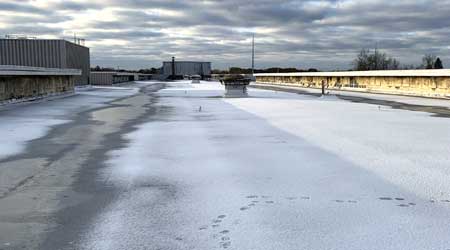 Doing regular inspections after snow or ice can help prevent costly repairs during the winter months.John D'Annunzio
Doing regular inspections after snow or ice can help prevent costly repairs during the winter months.John D'AnnunzioFacilities Manager's Guide to Winter Roofing Care
Roofs that are not properly cared for during the winter will bring unpleasant surprises when the weather warms.
Winter weather is upon us, and it can have a negative impact on the roof system. If the roof is not properly cared for, roof problems caused by winter conditions can lead to everything from interior leaks to roof material damage to structural collapse. Facility managers should develop a winter roof management plan that incorporates inspections, maintenance actions, and repair procedures that take effect before and after winter storm events.
A range of winter weather conditions could have an impact on the roof system: cold temperatures, high winds, and precipitation. For facility managers, the first step to prevention of problems is identifying the roof problems associated with these events. Also, understanding best practices on how to maintain and repair these conditions during the winter months is crucial. A properly executed winter roof management plan can eliminate costly roof repairs and extend the service life of the existing roof system.
Although roof materials are manufactured to protect the structure from the elements, certain weather conditions can create havoc for both low-slope and steep-slope roof assemblies. Most facility managers are aware that conducting roof maintenance inspections and making repairs in the fall are best practices to prepare the roof prior to the winter months. Preparation is indeed an important step; however, there are also steps to take during harsh winter weather that will be more beneficial in the long run. Colder weather and excessive precipitation are the primary problems that affect most of the country (to some extent) in winter months.
Temperature swings
A decrease in temperature can have a negative impact on roof materials if temperature fluctuations are extreme. The most extreme temperature fluctuations are typically in northern climates, although this is a relative concern in all regions. For instance, a daytime temperature of 70 degrees F and a nighttime temperature of 40 degrees F is common in the southeast and southwest and equates to a temperature drop of 30 degrees within hours.
Variance in temperatures contributes to expansion and contraction of materials. Because roof assemblies are a system of materials, all of the materials expand and contract independently (known as differential movement) due to the continual freeze/thaw process. This condition causes roof system deficiencies such as loss of attachment, which creates membrane blisters/ridges and membrane openings/splits at blisters/ridges. Moisture presence in the insulation will also contribute to these defects.
One smart strategy to negate extensive problems from membrane splits and openings is to monitor and repair existing blisters/ridges at formation. In harsh conditions, temporary repairs should be made to eliminate moisture intrusion into the building. Permanent repairs should then be completed once conditions are favorable for proper repairs.
Colder temperatures are often accompanied by gusting winds. Any loose, unsecured, or unattached roof materials are susceptible to displacement during these events. The most common points of roof displacement occur at perimeter edges, with problems occurring at flashings and metal terminations. Another risk is separation of material from the assembly, which can be catastrophic. Damage can also occur from the impact of displaced material on the roof membrane. This can create several membrane splits or openings that will allow moisture into the building at several points.
Best practice is to ensure all roof materials and components are properly secured during the winter months.
Related Topics:














